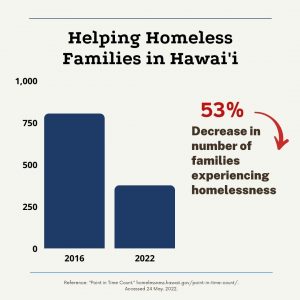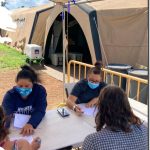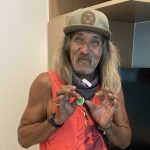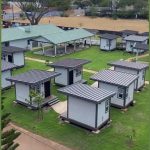It takes a village: Breaking the cycle of homelessness
Posted on May 31, 2022 in Capitol Connection, Featured, Main
Governor Ige with state homelessness coordinator Scott Morishige, who recently was honored for his leadership by the Hawai‘i chapter of Mental Health America.
Partnerships. Resources. Persistence. That’s what service providers and homeless coordinators say it takes to get people off the streets and into safer, stable housing. Even though clusters of homeless folks still appear in some neighborhoods, a small army of dedicated workers has made a measurable difference in the past eight years for homeless families and individuals. “We’ve been able to make positive changes in people’s lives, especially for families with young children, to break the cycle of homelessness,” said Scott Morishige, the governor’s homelessness coordinator. He recounts stories of people who have been homeless for years — such as the woman who lived under the viaduct on Nimitz Highway for over 20 years or the fellow who lived at Ala Wai Small Boat Harbor for 23 years who were able to be housed in an ‘Ohana Zone complex.

Finding real solutions, even in a pandemic —“People have a hard time understanding how anyone could choose to live on the street rather than accept help,” said Morishige. “But if folks have been through so much trauma in their lives, you get into a cycle that’s familiar. You know how to cope from day to day, and it’s hard to think beyond that. I know one couple who used to be my client 21 years ago when I first started out in social services. They were homeless then and are still homeless now. I don’t think either of them was ever in a stable home and grew up homeless themselves. That’s the cycle we need to break.”
Morishige is quick to point out the complex scope and the collaboration it takes at the state and county levels to respond to people’s needs in different ways. The ‘Ohana Zones initiative was originally intended to support only six projects, but partnerships with the four counties and state agencies produced 20 projects statewide. As of November 2021, the program had served 5,510 individuals, including 1,368 placed into permanent housing. The projects range from supportive housing for families with children to housing for seniors and domestic violence survivors to Kama’oku Kalaeloa, a village of 36 tiny homes, as a partnership with the Office of the Lt. Governor, the Hawai‘i Public Housing Authority, the City & County of Honolulu, and HomeAid Hawaii. The program is operated by U.S. Vets with ‘Ohana Zone funds for rent subsidy and support services.
Morishige said the statewide reductions in the number of homeless individuals between 2016 and 2022 — including an over 53% decline in family homelessness — shows it is possible to mitigate and reverse future increases in homelessness. Looking back, he said he appreciated that Governor Ige didn’t hesitate to take on the issues in a way that looked at the underlying systemic things that needed changing. “Focusing on those system issues isn’t always the most visible or flashiest, but they can make a real difference,” Morishige said. “I know the governor gets heat about being deliberative in making decisions, but actually that’s one of his strengths. He’s a collaborative leader who listens to other views. I’ve seen people really pressure him and get mad at him. But he stays level-headed and analyzes the issues before deciding what makes the most sense for the state. He doesn’t get mad or throw anyone under the bus. He just stays focused on moving forward.”
With Ohana Zones, the state has reached more than 5,000 people across 20 sites through outreach, transitional shelters and permanent housing. Clarence and Shoni have moved into stable homes in places like Kumuwai for seniors and Kama’oku Kalaeloa, the tiny homes village.




